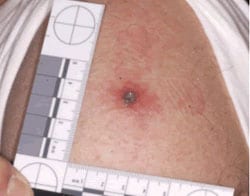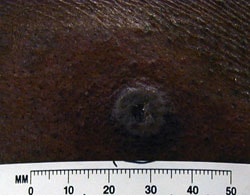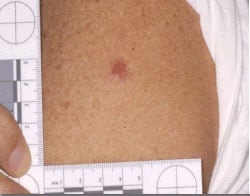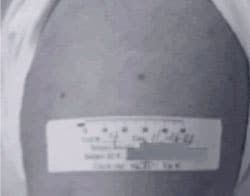Vaccine “Take” Evaluation
This information is about preventing or responding to smallpox. For the latest information about the current mpox outbreak, including information on symptoms, prevention, and vaccines, please visit CDC’s Mpox site.
A “take” or “major cutaneous reaction” indicates successful vaccination. A normal take will show a pustular lesion or an area of definite induration or congestion surrounding a central lesion, which can be a scab or an ulcer. Anything else is considered a “non-take.”
Non-takes can be caused by improper vaccination technique, use of vaccine that has lost its potency, or residual vaccinial immunity among previously vaccinated persons. Do not presume a person with a non-take to be immune to smallpox. Revaccinate anyone with a non-take reaction using a different vaccine lot.
Evaluate the vaccine site for both first-time vaccinees and revaccinees on the 6th, 7th, or 8th day following vaccination. Vaccine site evaluations on other days may not be reliable.
Examples of “takes”
The three images below both clearly demonstrate a central lesion.

Arm of vaccinated patient showing a central lesion, indicating a successful “take.” Source: Ramzy Azar, LTJG, MSC, United States Navy: National Naval Medical Center, Bethesda, MD.

Arm of patient with central lesion at smallpox vaccination site. Ruler showing diameter of lesion is approximately 1 centimeter. Central lesion shows a successful “take.” Source: Ramzy Azar, LTJG, MSC, United States Navy: National Naval Medical Center, Bethesda, MD.

Grayish pustule, with difficult to detect surrounding erythema in dark skin. Source: NIH, digital enhancement ©Logical Images, Inc
See additional images of Examples of Major or “Take” Reactions to Smallpox Vaccination
Examples of “non-takes”

Arm of patient who was unsuccessfully vaccinated for smallpox. Vaccination site has an area of erythema but no central lesion. Source: Ramzy Azar, LTJG, MSC, United States Navy: National Naval Medical Center, Bethesda, MD.

Arm of patient with a non-take at the vaccination site. The vaccination site has neither erythema nor a central lesion. Source: Stephen Heyse, MD, National Institutes of Health.
See additional images of Comparison of Reactions for Primary Vaccines and Revaccinees
Smallpox Vaccination and Adverse Reactions: Guidance for Clinicians Source: MMWR 2003, 52(RR04);1-28.
Surveillance Guidelines for Smallpox Vaccine (vaccinia) Adverse Reactions, 2006 Source: MMWR 2006, 55(RR01);1-16.